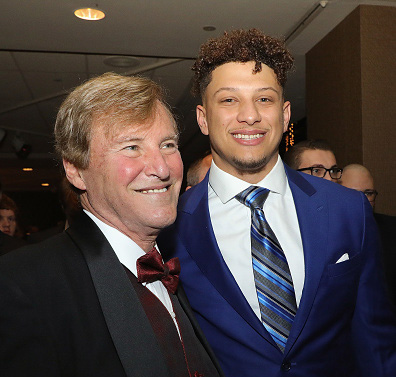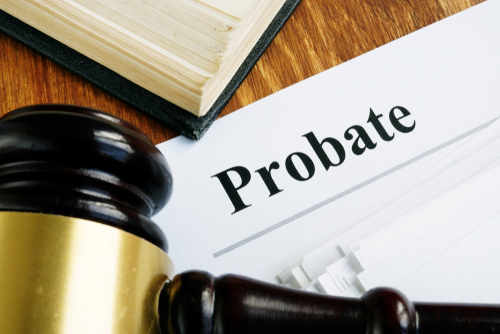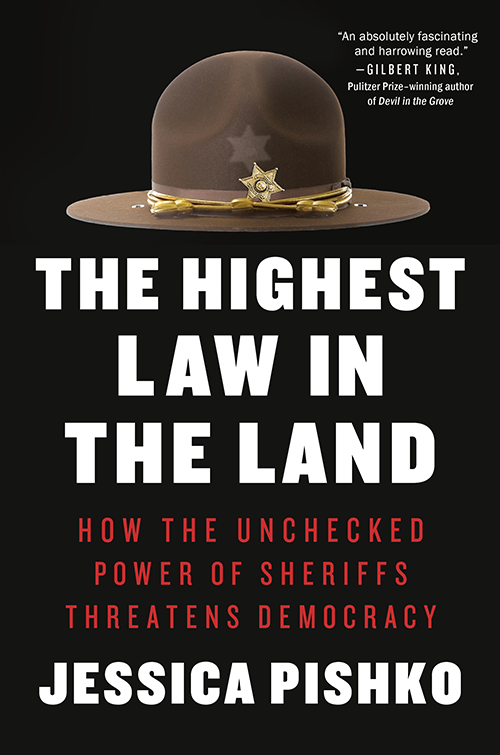The Real Jerry Maguire: An interview with sports agent and lawyer Leigh Steinberg

Lawyer and sports agent Leigh Steinberg represents Patrick Mahomes of the Kansas City Chiefs. Photo by Bill McCay/Getty Images.
How often, I ask Leigh Steinberg, do people say to you, “Show me the money?” “How about every day?” he responds without a second of hesitation. The phrase was cemented into pop culture lexicon by its use in Jerry Maguire, the 1996 film starring Tom Cruise as a sports agent, telling the story of his relationship with the profession and one particularly demanding football player-client.
Steinberg, a California lawyer, is asked so frequently about “those four words” because he was the inspiration for the film’s title character.
The famous agent’s client list expanded in 2021, after the longtime NCAA prohibition, against college athletes being compensated for their name, image and likeness ended. The door to endorsement deals and other financial opportunities burst open.
As a result, many collegiate athletes and even high schoolers are asking the sports agent—who’s represented the No. 1 overall pick in the NFL draft eight times—to show them the money.
NIL, as the athletes’ intellectual property rights have come to be called, is an historic change for NCAA sports. But the sports agentry business and the legal profession also stand to feel its effects. NIL practice groups have sprung up at many firms to address the consequent legal issues. More lawyers have the coveted opportunity to represent athletes. Even would-be lawyers have gotten in on it. A handful of law schools have added NIL clinics to their course offerings.
On the eve of a new college football season, Steinberg, in a Zoom interview from his Newport Beach, California, office—where a cereal box featuring his client MVP quarterback Patrick Mahomes sits to the side his desk—discussed some impacts of NIL on the sports agentry and legal professions.
Accidental sports agent
The 74-year-old Steinberg, who looks about half that, didn’t set out to be a sports agent. While a student at the University of California at Berkeley School of Law, he served as a dorm counselor for undergraduates. Steinberg became friends with a resident named Steve Bartkowski, the school’s quarterback. In 1975, Bartkowski was chosen by the Atlanta Falcons as the NFL’s No. 1 draft pick.
Bartkowski was unhappy with the progress his agent was making in reaching an agreement with the team. He asked Steinberg, 26 and fresh out of law school, to take over as his agent. Working out of the card room in his parents’ house, Steinberg secured a four-year deal for Bartkowski worth $600,000—the most lucrative rookie contract in NFL history at the time.
Steinberg had been weighing whether to take a job with the Alameda County, California, prosecutor’s office or pursue corporate litigation. Instead, he started a sports agency.
 Actor Tom Cruise talks on a phone in a scene from the film Jerry Maguire in 1996. Photo by TriStar/Getty Images.
Actor Tom Cruise talks on a phone in a scene from the film Jerry Maguire in 1996. Photo by TriStar/Getty Images.
Changes to the agentry business
When considering a prospective client, Steinberg tells me he wants to be sure they have “the requisite work ethic and commitment to excellence.” His clients also should be willing to be role models and perform charitable work in their hometowns, college communities and at the professional level.
Before NIL, Steinberg represented college athletes as juniors and seniors to help them transition to the professional ranks. “That’s a mature young person we’re looking for,” he tells me.
“All of a sudden,” Steinberg says, “you have high school—soon to be college—athletes branding themselves at 16 or 17 and looking to hire a marketing agent. That’s a drastic change in terms of the age and maturity at which I would first meet an athlete.”
For lawyers, Steinberg says NIL is “another route” into the agentry business. With more athletes needing the services of a marketing agent, “it offers the opportunity for more growth in the field—more potential jobs.” In football, Steinberg points out, a small number of agents represent a large percentage of the players.
But could more agents increase the risk of unscrupulous ones, I ask Steinberg. Before answering, the man who has taught the sports agent business at law schools and for many years run an academy for aspiring agents first offers some background.
“Let’s start by saying that the sports agent field is heavily regulated at this point,” he says. To represent a player in a team sport, the agent must be certified by the players association. On top of that, Steinberg rattles off “a whole set of rules and regulations” that govern agent conduct in team sports.
Steinberg notes various state labor regulatory rules that agents must follow. There also are university policies on athlete recruitment that cover agent conduct. As a member of the California bar, he has obligations that flow from that as well.
Now “NIL comes along, and there’s no regulation of marketing agents,” Steinberg says. “So the answer is absolutely, the potential exists for misrepresentation.” Traditionally, he explains, an athlete can do due diligence on a prospective agent. “This doesn’t exist [in NIL]. At some point, you might have people without major qualifications or experience who make good presentations and sign players.”
Lawyers taking notice
NIL has created a bonanza of legal issues. Numerous law firms have started practice groups offering to address concerns that athletes have, such as contract drafting, intellectual property, asset protection and taxation. Firms also are offering assistance with the nascent and rapidly evolving NIL compliance issues.
NIL arrangements are the subject of NCAA rules and numerous states have adopted laws pertaining to them. It’s a patchwork of do’s and don’ts that don’t always coalesce. In June, the NCAA stated that when state law and NCAA rules clash, “institutions must follow NCAA legislation.”
Some states see it differently, saying schools that follow their rules over the NCAA’s cannot be punished by the collegiate governing body. Congress also has expressed substantial interest in having a place at the regulatory table.
But for lawyers who see NIL as a way to take advantage of increased opportunities to represent athletes, the law library is not where their work should begin.
“If [an athlete] wants to do NILs, the process starts with branding them,” Steinberg says. “What does their website look like? How do they appear on social media? The currency of endorsement and marketing deals is [number of] followers on social media.” Are there enough “eyeballs” to create a “revenue stream”?
So a key part of the marketing agent’s job, Steinberg explains, is to teach the athlete how to maximize their social media presence, including how to “produce content on a steady basis.” Once that’s in place, “marketing is marketing.”
Law schools also getting into the game
I ask Steinberg what law schools can do to prepare their students interested in entering the NIL field. His response does not fit into any traditional casebook: “Have a course in social media.”
How about advice for law students? At this point, his answer is not surprising: “Brand yourself.” Lawyers too, Steinberg says, would benefit from this. “Lawyers are always trying to brand themselves.”
Law students, he says, “can write an article on NILs. They can come up with a new theory on NILs.” Steinberg counts 85 law school campuses on which he has spoken. He tells students, “Learn how to distinguish yourself from everyone else.”
The University of Oregon School of Law’s business law clinic offers students the opportunity to learn NIL skills. The future lawyers review contracts and provide assistance to student athlete-clients with meeting obligations such as posting on social media, making in-person appearances, doing speaking engagements, photo shoots and autograph signings.
Laurie Hauber, director of experiential education and assistant clinical professor of law there, tells me by email, “We want student athletes to have the knowledge they need in order to make an informed decision as to whether a particular NIL contract is in their best interests.”
The University of Minnesota Law School has a sports & NIL run clinic by Chris Pham, an attorney from Minneapolis-based Fredrikson & Byron, that provides students with the chance to work with student-athletes from various Upper Midwest schools. It addresses such things as compliance issues, due diligence on brands offering deals and contract review.
The law school’s course description calls it a “placement clinic, and clients will be entering into representation agreements with attorneys at Fredrikson & Byron, P.A.”
Baton Rouge, Louisiana-based injury attorney Gordon McKernan has found another way in which lawyers can become involved with NIL. His firm’s website features dozens of athletes from several Louisiana universities, across numerous sports, adorned in T-shirts featuring his firm’s logo. “I think there’s a lot of value for helping a student athlete and at the same time helping our company,” McKernan says on his site.
On the wall behind Steinberg is a photo of him flanked by Tom Cruise and Cuba Gooding Jr., who played the challenging client in Jerry Maguire.
“Steve Bartkowski probably saved me from a life of legal drudgery.”

Randy Maniloff is an attorney at White and Williams in Philadelphia and an adjunct professor at the Temple University Beasley School of Law. He runs the website CoverageOpinions.info.
This column reflects the opinions of the author and not necessarily the views of the ABA Journal—or the American Bar Association.



